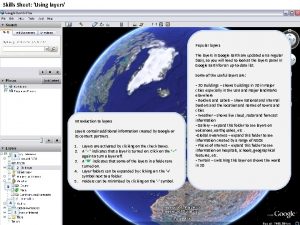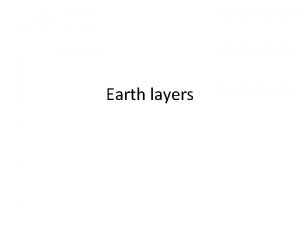When Mixed Layers Are Not Mixed Using Vector








- Slides: 8

When Mixed Layers Are Not Mixed: Using Vector Wind Products to Evaluate Storm Recurrence and Upper Ocean Mixing Magdalena M. Carranza 1, Sarah Gille 1, Peter J. S. Franks 1, Kenneth S. Johnson 2, Robert Pinkel 1, James B. Girton 3 1 Scripps Institution of Oceanography, UC San Diego, 2 Monterey Bay Aquarium Research Institute, 3 University of Washington IOVWST 2018, Barcelona

Mixed Layers in the Southern Ocean Mixed layer defined by homogenized density Deepening of mixed layer brings cold water and nutrients to surface Possible factors: • Direct wind forcing (21. 8% of mixed layer variance) • Buoyancy forcing (16. 7%) • Ekman pumping (smaller) (Carranza and Gille, 2014)

Mixed Layers vs Mixing Layers Mixing layer: Actively mixing now Mixed layer: Homogenized in density Could be remnant of previous mixing event Blue line: density Green line: phytoplankton biomass (represented by fluorescence or backscatter)

Observed profiles show Chl-a or backscatter varies within mixed layer Deep chlorophyll maximum within mixed layer 20 -40% of time, depending on season Deep chlorophyll maxima can also occur below the base of the mixed layer

Schematic framework Storm events deepen and homogenize mixed layer When storm ends, density remains mixed and top of mixed layer might continue mixing; phytoplankton grow where mixing is minimal

Schematic framework Use CCMP winds to assign timescales Storms: wind speed > 10 m/s Storm events deepen and homogenize mixed layer When storm ends, density remains mixed and top of mixed layer might continue mixing; phytoplankton grow where mixing is minimal

Storm recurrence timescales Storm recurrence ~7 days Storm duration ~3 days Time between storms: ~4 days Interstorm period slightly longer in summer Time scales imply biological restratification occurs within 2 days

Summary/discussion • Subsurface backscatter or fluorescence maxima frequently occur within the Southern Ocean mixed layer • One explanation: storms mix, and between storms phytoplankton preferentially grow at the base of the mixed layer. (Mixing? nutrients? ) Can we match individual profiles to storms? Less successful, implying that CCMP mapping does not capture all storms perfectly. • Southern Ocean OOI mooring (when data went on GTS, ECMWF forecast saw immediate change) • Ocean waves detected by Ross Ice Shelf seismic stations (~50 -60% of wave events detected at ice can be traced to identifiable storms)














